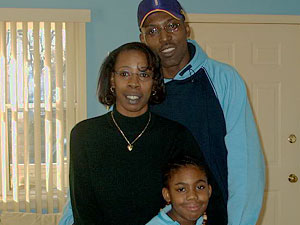|
Photos
Respond to this story
|
Resurgence in gang activity troubles Minneapolis officials
December 31, 2002
 |
| Tyesha's parents, Linda Longino and Lawrence Winborn, are dedicating their time to anti-violence efforts. They're shown with daughter, Lakia. (MPR Photo/Brandt Williams) |
Minneapolis, Minn. — Of the murders committed in Minneapolis this year, none has received as much attention as the killing of 11-year-old Tyesha Edwards. Since she was shot by a stray bullet in her home in November, police and community activists have used her case as a rallying cry against violence. A coalition of black ministers has started an anti-violence initiative in her name. And a local artist wrote a song about her called "Tears for Tyesha."
Tyesha's parents, Linda Longino and Lawrence Winborn, are also dedicating their time to anti-violence efforts. Longino says she hopes she can help prevent this kind of thing from happening to someone else's family. She says it's still really hard to accept that her daughter is gone.
 | |||
"The person in the family that was the funniest, that kept the jokes going and liked to scare you and jump out of places. That whole personality, that whole person is just no longer there," she says.
Tyesha's death was the 41st homicide of the year. And police officials are counting it as one of the city's 25 gang or drug-related murders because they say the three suspects were gang members. A report from the Minneapolis police department shows that between 1998 and 2000 nearly 70 percent of homicides were gang or drug-related.
"The greatest amount of our homicides over the last few years have been either gang or drug related; sometimes a combination of both," according to Minneapolis homicide unit supervisor Lt. Bob Skomra, who has been a police officer in the city for over 30 years.
He says when he first started on the force, most murders involved people who lived together or were related by blood or marriage. In Skomra's office, sheets of 8 1/2 by 11 inch paper cover the upper half of one wall. On each piece of paper is the name of a homicide victim, and a few details of his or her death. People like Ethan Graham, a young man who was shot by a stray bullet while he opened a window in his apartment. And the year's youngest homicide victim, DeShawn Copeland, who was just two years old.
Skomra looks over the sheets and tallies how many of this year's murders involve firearms -- 32. Just over half the sheets are white, representing cases where at least one suspect has been charge. Red sheets mean police are still looking for suspects. However, he says that doesn't mean they don't have an idea of who was involved. Skomra says many times murders are the aftermath of fights between known gang members.
"It's very frustrating for a homicide detective who does assaults also to have to deal with that. They know or most times they know someone who's responsible but proving it is very difficult in the gang culture," Skomra says.
 | |||
Police officials say the best evidence in homicide cases comes from eyewitnesses. However, they say in gang-related cases, witnesses often don't come forward because of fear of retaliation.
But the Tyesha Edwards case was different. Police officials credit community members for coming forward with information which helped them arrest suspects a few days after the shooting.
In early December police chief Robert Olson and other police officials held a meeting at a school several blocks from where Tyesha Edwards was killed. Olson praised community members for their help and announced that the Minneapolis police department would be adding six officers to the Minnesota Gang Strike Force.
Capt. Stacy Altonen is the commander of the Minneapolis police department's Special Investigations Division, which deals directly with gangs. Altonen says she believes the level of community-police cooperation present in the Edwards case will continue.
"It's evident in many neighborhoods in Minneapolis. This one happened, unfortunately, to rally around a very tragic incident. But a lot of great neighborhoods in the city that have that same support," according to Altonen.
Police officials also say they're hopeful that the information they received in the Tyesha Edwards investigation can help them solve other gang-related murders and perhaps prevent further killings.
|
News Headlines
|
Related Subjects
|
